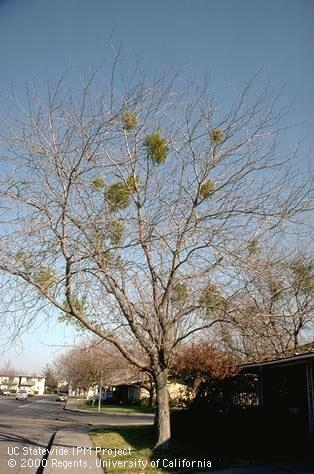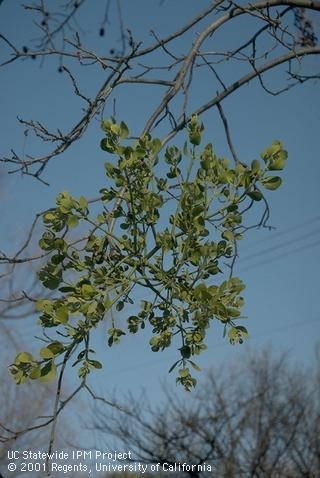You may have seen Mistletoe hung in doorways over these past few weeks. It is a traditional holiday decoration, but when it's growing on trees in the landscape, this parasitic plant may not seem quite as charming.
There are two types of mistletoe: broadleaf and dwarf.
Broadleaf mistletoe (Phoradendron macrophyllum) is an evergreen parasitic plant that grows on a number of landscape tree species in California. Hosts of broadleaf mistletoe include alder, Aristocrat flowering pear, ash, birch, box elder, cottonwood, locust, silver maple, walnut, and zelkova. Other species of broadleaf mistletoe in California include P. villosum, which infests only oaks, and Viscum album, which attacks alder, apple, black locust, and cottonwood.
Dwarf mistletoes (Arceuthobium spp.) infest pines, firs, and other conifers in forests, and can be a problem in forest landscapes such as in the Sierra Nevada foothills.
Leafy mistletoes have green stems with thick leaves that are nearly oval in shape. Plants often develop a rounded form up to 2 feet or more in diameter. The small, sticky, whitish berries are produced from October to December.

After the mistletoe seed germinates, it grows through the bark and into the tree's water-conducting tissues, where rootlike structures called haustoria develop. The haustoria gradually extend up and down within the branch as the mistletoe grows. Initially, the parasitic plant grows slowly; it may take years before the plant blooms and produces seed. Broadleaf mistletoes have succulent stems that become woody at the base. Old, mature mistletoe plants may be several feet in diameter, and on some host species, large swollen areas develop on the infected branches where the mistletoe penetrates. If the visible portion of the mistletoe is removed, new plants often resprout from the haustoria.
Dwarf mistletoes are smaller plants than broadleaf mistletoes, with mature stems less than 6 to 8 inches long. Dwarf mistletoe shoots are nonwoody, segmented, and have small scalelike leaves. While broadleaf mistletoe seeds are dispersed by birds, dwarf mistletoe seeds are spread mostly by their forcible discharge from fruit, which can propel seeds horizontally into trees up to 30 to 40 feet away.
Broadleaf mistletoe absorbs both water and mineral nutrients from its host trees. Mistletoes also can produce energy through photosynthesis in their green leaves. Healthy trees can tolerate a few mistletoe branch infections, but individual branches may be weakened or sometimes killed. Heavily infested trees may be reduced in vigor, stunted, or even killed, especially if they are stressed by other problems such as drought or disease.
In newly developed areas or in older established areas where trees are being replaced, the ideal method of controlling or preventing mistletoe is to plant trees believed to be resistant or moderately resistant to mistletoe. Avoid trees like Modesto ash, known to be especially susceptible to mistletoe infestation. Some tree species appear resistant to broadleaf mistletoe. Bradford flowering pear, Chinese pistache, crape myrtle, eucalyptus, ginkgo, golden rain tree, liquidambar, sycamore, and conifers such as redwood and cedar are rarely infested. These or other resistant species should be considered when planting in infested areas, or when replacing infested trees.
For treatment of existing trees it is important to remove mistletoe before it produces seed and spreads to other limbs or trees. Mechanical control through pruning is the most effective method for removal. Growth regulators provide a degree of temporary control but repeated applications are required. Severely infested trees should be removed and replaced with less susceptible species to protect surrounding trees.
The most effective way to control mistletoe and prevent its spread is to prune out infected branches, if possible, as soon as the parasite appears. Using thinning-type pruning cuts, remove infected branches at their point of origin or back to large lateral branches. Infected branches need to be cut at least one foot below the point of mistletoe attachment in order to completely remove embedded haustoria. It is best to call an arborist if mistletoe is infesting your trees and you are unable to reach it to prune it.
Mistletoes infecting a major branch or the trunk where it cannot be pruned may be controlled by cutting off the mistletoe flush with the limb or trunk. Then wrap the area with a few layers of wide, black polyethylene to exclude light. Use twine or tape to secure the plastic to the limb, but do not wrap it too tightly or the branch may be damaged. Broadleaf mistletoe requires light and will die within a couple of years without it. It may be necessary to repeat this treatment, especially if the wrapping becomes detached or if the mistletoe does not die.
Simply cutting the mistletoe out of an infested tree each winter, even without wrapping, is better than doing nothing at all. Even though the parasite will grow back, spread is reduced because broadleaf mistletoe must be several years old before it can bloom and produce seed.
For a list of Certified Arborists in our area or for more information related to mistletoe, you can contact the UC Master Gardeners at 209-953-6112. More information can be found on our website: http://sjmastergardeners.ucanr.edu/CONTACT_US/